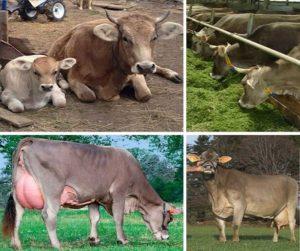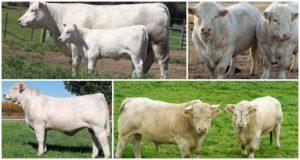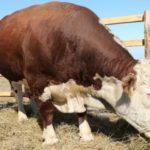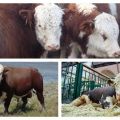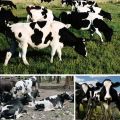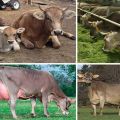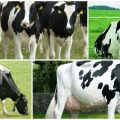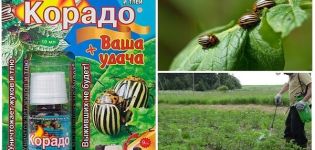Characteristics of Kazakh white-headed cows, advantages and disadvantages of the breed
Farms focused on the production of meat products often choose Kazakh white-headed cows for breeding. Cattle owners consider this breed to be one of the best. The livestock is distinguished by high productivity and unpretentious care. Animals are not intimidated by the harsh climate; they easily adapt to different conditions.
Origin history and prevalence
Work on the development of the white-headed breed continued for 20 years. A special base was created in Kazakhstan for these purposes. The breeders chose local cows and breeding Hereford bulls for crossing. The best animals were kept for the next attempts. Painstaking work was crowned with success. The breed was officially approved in 1950. Scientists who took part in breeding activities were awarded state prizes first by the Kazakh Republic, and then by the USSR.
Meat animals can spend time grazing all year round. They cover about 30 kilometers every day. The dairy type of cows is also unpretentious in care. Livestock is transferred to enhanced nutrition in winter. This helps to keep the milk yield at a high level.
Appearance and characteristics of the breed
Kazakh white-headed cows have a number of characteristic features that give importance to the breed. Distinctive features of animals:
- A white color that is present in the coloration of the head, belly and on the tip of the tail. The rest is in different shades of red.
- The sturdy body is barrel-shaped.
- Due to the large weight, the limbs of the animals are short. This leg length gives stability while moving.
- The condition of the coat varies with the season. In winter, the cover becomes thick and wavy, in summer it looks like other cows.
- Thanks to the elastic skin, the animal easily gains and loses weight several times during the year.

Calves reach 250 kilograms by 8 months of age. An adult bull weighs about 900 kilograms, while cows weigh more than 500.
Milk production indicators depend on the type of animal:
- Meat cows produce about one and a half tons of milk per year.
- Meat and dairy milk yields reach 2.5 tons.
- Dairy varieties allow you to get up to 6 tons within 365 days.
The fat content of the drink is 4.8%. The meat is juicy and tasty, with a characteristic marble layer of fat.
Pros and cons of the Kazakh white-headed breed
The white-headed cows combine the best qualities of the Hereford bull and the Kalmyk breed.
The Kazakh white-headed breed has many advantages, and breeders are working to eliminate the shortcomings. Therefore, domesticated cows rarely live up to 25 years. At livestock enterprises, there is a constant process of culling individuals in order to increase productivity.
Subtleties of content
Farmers consider the free keeping of cows on pastures as optimal conditions for the breed. Animals can easily move long distances. An impressive body fat helps maintain weight. Calves stay with the rest of the livestock. The offspring always has the opportunity to receive the necessary portion of breast milk.
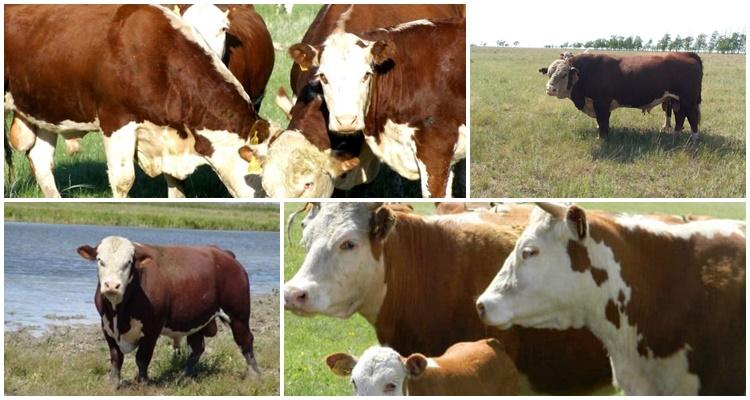
The construction of sheds in pastures makes the conditions more comfortable. Straw bedding, which does not remove but only adds new portions of hay, helps keep warm in winter.
Such technology:
- Does not require large costs for maintenance and animal maintenance.
- Reduces the cost of feeding young animals.
Cowsheds are also suitable for placing the Kazakh white-headed breed. The arrangement has a number of features:
- A calf pen is set up in the middle of the room.
- Bedding is placed around the perimeter of the building and feeding areas are in the center.
- Body cows are kept in separate fenced areas.
This method makes it easier for the farmer to care for the animals and control the livestock.
Drawing up a diet
Fresh grass, hay and straw form the basis of the diet of white-headed cows. Meat-type animals tolerate roughage well. Bulls are supported by grain and legumes. The required level of nutrients in the body is supported by the use of vitamin complexes and bone meal.
In winter, the cows are transferred to silage. To do this, provide a sufficient supply of corn, sunflower and hay. Beets compensate for the lack of sugar in the diet. Newborn calves up to 3 months old feed on colostrum. Gradually, the young are transferred to compound feed. From an adult cow, offspring are weaned after reaching 6 months of age. Up to 1 year of age, the daily diet of calves consists of:
| Food | Weight |
| Sulfur | 6 g |
| Phosphates | 35 g |
| Salt | 45 g |
| Hay: | |
| Legume | 1 kg. |
| Cereal | About 3 kg. |
| Straw | 1 kg. |
| Beet | 2 kg. |
| Concentrated feed | 2 kg. |
| Corn silage | 8 kg. |
As you grow older, the number of foods is gradually increased. By the age of two years, legumes and beets are excluded from the diet of young animals, and the consumption of concentrates and sulfur is reduced.
Breeding rules
Cows reach sexual maturity at 1.5 years. For fertilization, natural methods are used. Artificial methods reduce the chance of conception by 10%. For insemination in a herd, 1 male per 35 adult animals or 1 bull per 25 young females is sufficient.
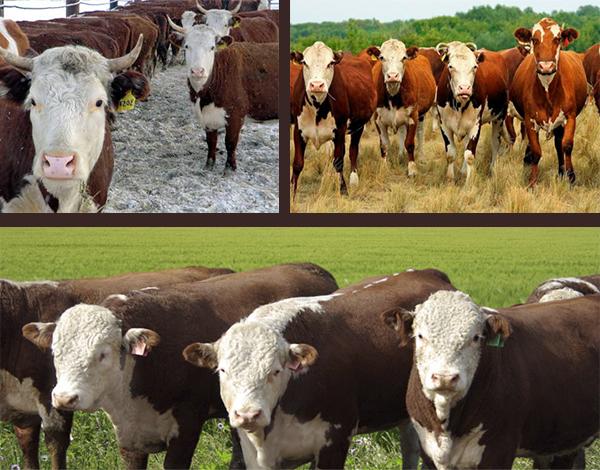
The survival rate of the offspring of the Kazakh white-headed breed is almost 100%. The female reproductive properties remain up to 15 years. During pregnancy, animals are heavily fed.Childbirth is easy, without human help. Usually cows bring 1 calf. During life, animals are able to reproduce up to 15 heads of offspring. Newborns do not require special care. After milk has emerged, the cow is again ready for fertilization.
The offspring gains weight quickly. Calves consume about 1.5 tons of milk. Meat cows are not milked during this period. All products are used to feed the offspring. And by the age of puberty, bulls gain almost 200 kilograms. Any difficulties in the development of animals mean errors in feeding or keeping. In this case, you need to consult a veterinarian.
Disease prevention
Representatives of the Kazakh white-headed breed usually have strong immunity. Sometimes animals are susceptible to infectious or invasive diseases. In some cows, genital pathologies are observed.
Diseases affecting cattle:
- Leptospirosis often leads to the death of an animal or the birth of a dead calf in calf cows. The virus is transmitted through water or through infected individuals. To prevent contamination of the entire herd, patients are isolated during treatment.
- Catarrhal fever affects the lungs, intestines, or nervous system. Pathology occurs when small and cattle are kept together.
- Dirt in the room provokes the development of necrobacteriosis. In the initial stages, the problem is eliminated by using antiseptics.
- Decreased appetite and fever is observed in calves with eimeriosis. In addition to the treatment, which is agreed with the veterinarian, the prevention of the premises is carried out. The pen for keeping animals is treated with an ammonia solution.
- Mastitis is the most common disease in cows that have reproduced. Compresses are applied to the sore udder and massage is done. In severe cases, antibiotic injections are used. Milk after such treatment is unusable.
The free keeping of animals on pastures often leads to injuries. Small bruises or scratches are treated with iodine or brilliant green. Deep wounds are sutured, this requires the participation of a doctor.

Where can you buy
Farmers highly value Kazakh white-headed cows. Animals are bred by many farms in Ukraine, Belarus and Kazakhstan. In Russia, pedigree offspring are offered by livestock complexes in the Urals and in the Volgograd region. The price for young animals starts from 120, heifers - from 150 rubles per kilogram of live weight. Adults are even more valuable.
The most expensive are animals with record productivity. Such cows are used to improve the quality of the breed.
Recommendations from veterinarians
The optimal amount for breeding the Kazakh white-headed breed is considered to be from 400 heads in a herd. Veterinarians recommend:
- Inseminate cows in spring and early summer.
- Do not wean calves from their mother for a month after birth. Milk strengthens the immune system of newborns.
- Clean the barn and clean the premises from rodents.
- Arrange regular vaccinations for animals.
It should be borne in mind that Kazakh white-headed cows prefer free movement and do not tolerate close corrals. Calm and unpretentious in care animals of the Kazakh white-headed breed are suitable for breeding for novice farmers. Maintenance costs are low and productivity is high. These factors create the conditions for making a profit.



